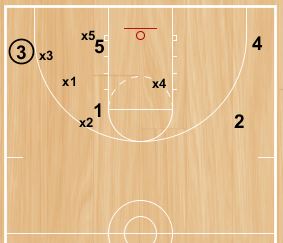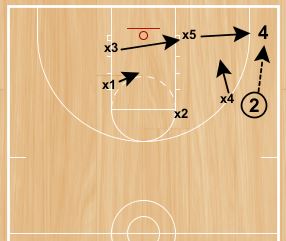
Multiple Zone Defenses–The Key to Maximizing Your Talent and Controlling Tempo
Presented by Will Rey, Head Coach Northridge Prep, Chicago.
His program’s three keys to maximizing your talent and controlling tempo are shot selection, minimizing turnovers, zone defense.
The “Zone Problem” in Basketball
- Zone defense is often not respected by coaches
- Coaches spend less time on zone attack
- Players don’t like to play against it
The “Zone Advantage in Basketball”
He uses these points to sell his players on the effectiveness of what they do.
- NBA doesn’t allow zones. The league that is most concerned with scoring points does not allow it which should at least be food for thought as to the effectiveness of zone defense. Editors note from Brian: My interpretation of Coach Rey’s statement is that even thought the NBA does allow zone defenses, they are not true zone defenses due to the defensive three second rule. Coach Rey is a very knowledgeable basketball coach and he does know that zone defenses are legal.
- Time. It doesn’t require as much time to teach zone defense because there are less movements and actions that opponents run against zone defense.
- Zone Defenses are counterintuitive to the way players see the game and train during individual skill development workouts and drills.
- Hard to Simulate it is difficult for opponents to prepare to play against in a few days what we have been working on for four years (seniors), three years (juniors)
Their results show that their multiple zone defenses are difficult to score against and they foul very little–another key to maximizing talent–keeping their players out of foul trouble and in the games.
What You Should Prepare for if you decide to become a “zoner”
When you play zone defense, you need to be prepared to receive criticism and you will get it. You will hear things like:
You are a compromiser
Your teams are soft
You are a “non-purist”
You are not teaching the game
Foundational Stones of their Zone Defenses
They need to work on, drill, and practice these defensive areas each day
- They can get to three point shooters.
- They have inside position for defensive rebounding.
- Good defense begins with good offense–shot selection and minimizing turnovers. The two parts of the game must be compatible within your system.
- Their players and coaches are committed to a system of multiple zone defenses.
- Northridge does not play zone, they teach it!
- If they are going to lose, they want to make the unknowns beat them. They emphasize scouting reports and shot charts for where the opponents individual players are most effective from.
- Air is not the enemy, don’t guard air! Guard the basketball, the box, or the elbow
Zones they play
23 slide
31 (1-3-1)
1-2-2
Combination 1-3 plus a chaser
Triangle and Two
Execution of their defenses
- Cover the elbows and boxes. If no one is there now, they will be coming.
- Teaching phrase, “Ball comes, I come”
- Guarding a skip pass is a three player operation
Teaching the 2-3 Slides
Diagrams created with FastDraw
9 offense, 5 defense, cover 1 pass at a time, then make the next pass.
They bump their forwards as little as possible.

Defend the post 3/4 around on the baseline side.
Fronting the post is an in game adjustment.
X1 is the plug position and plays facing the ball with his back to the top of the key. He is positioned to keep the ball out of the post.
X2 is the wedge and is just above the high post.

The three players involved in guarding the skip pass in the diagram at the left are:
x5 moving to guard the ball side block
x2 moving to guard the ball side elbow
x4 is the defender closing out on the basketball
They teach to closeout with one hand on the basketball and the other hand in the next passing lane.
The helpside forward must be aggressive and fearless. His focus is on covering the skip pass when it is made and weakside rebounding. He plays a step off the midline.
The coverage for when the ball is passed to the corner
Other actions they work to cover every day.
- Swing-Swing-Corner (perimeter swing pass, perimeter swing pass, then pass to the corner)
- Swing-Swing-Shot
- Skip pass-Corner
- E”merge”ncy (Merge on the basketball when it goes inside or to the elbow)
PGC/Glazier Basketball Clinics is a preferred partner of The Coaching Toolbox









“The NBA doesn’t allow zones?” Huh? They’ve been legal in the NBA for 16 years.
Might want to change that statement as it damages your basketball credibility. Zone defenses (with the exception of the defensive three-second rule) were legalized in the National Basketball Association prior to the start of the 2001-2002 season.
Hi Coach,
Thank you for your comment. I think when Coach Rey made that statement he assumed that most coaches would understand that the with Defensive 3 second rule, NBA zones are not true zone defenses. I will add that clarification for coaches who don’t realize the difference. I appreciate you taking the time to add your perspective! Brian